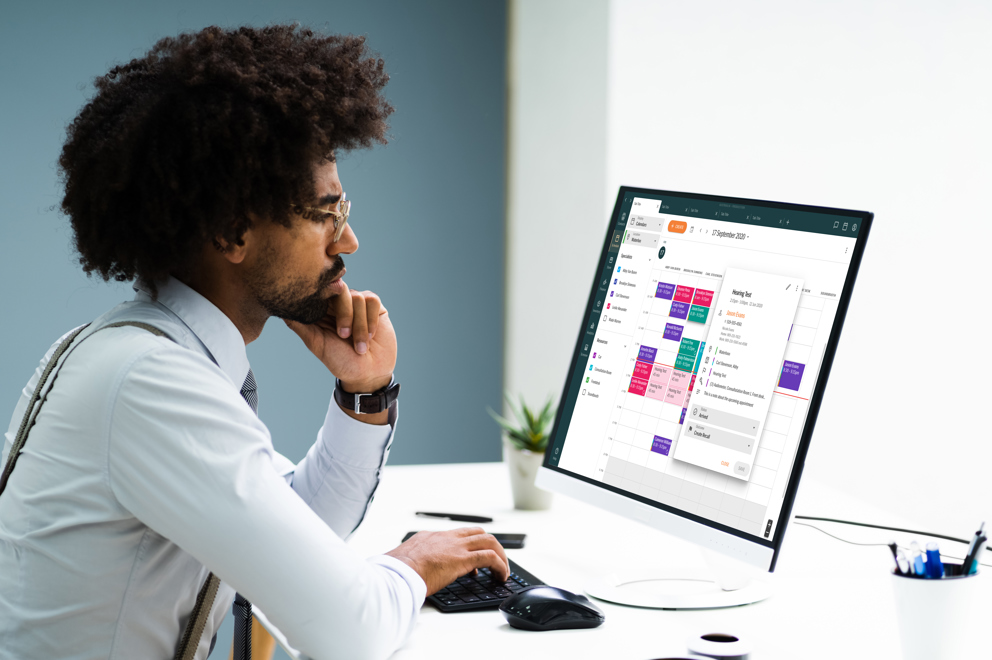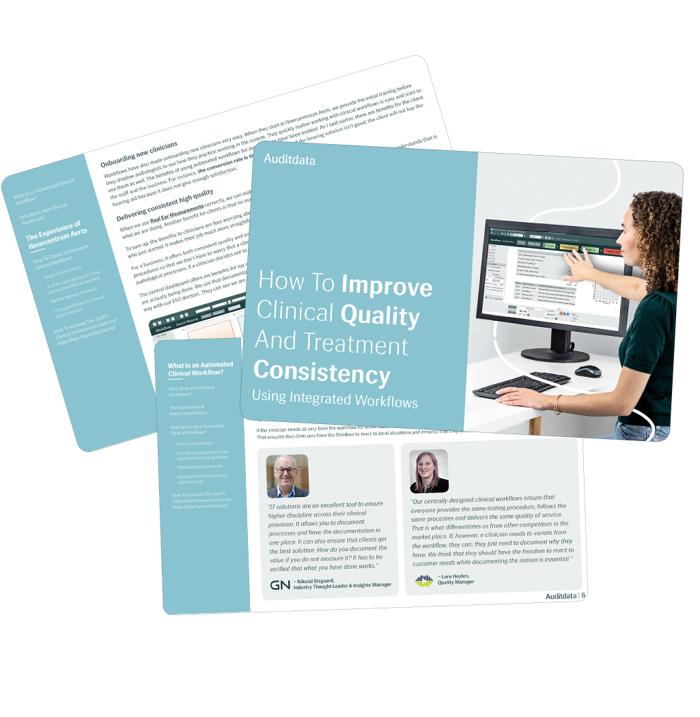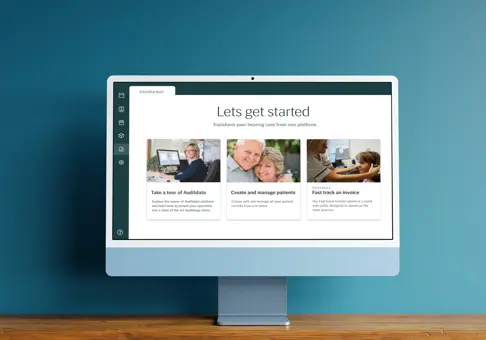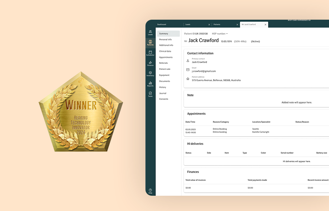
Working faster without compromising quality can seem like a pipe dream, but there are proven ways to use technology to boost efficiency in audiology clinics, while delivering high-quality clinical outcomes.
Think about it: Your staff is working already on a tight schedule, where they should treat clients properly, professionally, accurately, and compassionately – but now even more efficiently.
Quite often, your audiologists will have an hour or less to gather all relevant information and documentation, examine the client, suggest the most appropriate solutions to resolve their hearing loss, fit them with hearing aids, troubleshoot, and answer their questions.
Within that hour, the audiologist must determine each client’s audiological needs plus other variables, such as their age, lifestyle, budget, and expectations around their hearing solution. Then they must update all that information – often writing by hand on paper files or entering it into multiple IT systems rather than using more efficient tech systems.
The good news is that there are proven ways to boost your in-clinic operational efficiency.
1. Improve Your Scheduling

Schedule optimization is key to your organization’s success. The right solution allows you to utilize your resources wisely and keep things running smoothly and efficiently.
Do you have wait times of more than two or three days for first appointments? A simple rule of thumb is to book new prospects’ appointments within two or three days. Waiting much longer than that can turn that hot prospect cold.
The key to achieving this is to optimize your schedule to meet new customers while balancing existing customers’ service needs.
The National Institutes of Health reports that no-show rates range from 12% to 80% in various healthcare settings.
Two key reasons for no-shows are appointment waiting times longer than two to three days and a lack of communication with clients.
Using an advanced Practice Management Software, you can reduce client no-shows – which are a huge waste of your clinic’s precious time and resources – by setting automatic appointment reminders via email and text. The bidirectional texting feature allows you to engage with clients, such as giving directions to your clinics or rescheduling their appointment, if necessary.
We have designed this free guide to assist retail audiology businesses in optimizing their schedules for success. This scheduling strategy maximizes revenue, delivers opportunities, and visualizes all staff and resource availability across an enterprise.
2. Make More Of Your Existing Resources

It is commonly recognized that qualified staff (whether audiologists or board-certified hearing instrument specialists) is an increasingly scarce resource. A continual decline in available labor, coupled with rising salaries, makes it critical to optimize staff time and ensure that they are being well-utilized, while still providing high-quality clinical outcomes.
Automated tools, including scheduling and reporting, will allow you to maximize efficiency, utilize staff wisely, streamline workflows, review performance by clinic and/or audiologist, and adjust, as needed, based on data. These efforts help improve your resource utilization for better business performance and improved client care.
In a two-step process, you can use Auditdata Manage’s reporting capabilities in Discover to review the allocation of audiologists across appointments and activities to understand how your audiologists are spending their time. Ideally, they will be spending most of their time conducting client examinations, recommending solutions to treat clients’ hearing loss and fitting hearing aids.
Once you know how your audiologist's time is allotted, you will likely want to optimize the time spent. To accomplish this, be sure that your standard protocol allows your front office staff to qualify each client on the phone before booking an appointment with the audiologist.
This approach will not only optimize your resource allocation, but it will also lower your no-show rates, reduce audiologists' time spent with customers who have no hearing loss, and increase your customer satisfaction ratings.
Another way to assess customers’ or prospects’ hearing is through Auditdata Engage, a user-friendly screening tool. One of Engage’s benefits is that it doesn’t need to be administered by an audiologist. All staff members can help customers or prospects use the self-screener.
In addition to conducting screenings and pre-qualifying leads, have support staff – not audiologists – handle operational tasks, such as scheduling, ordering, marketing, etc. This frees up the audiologists’ time so they can focus on client exams and selling hearing aids.
Keep in mind that resources go beyond just staff utilization. If you have limited resources – such as a sound booth or frequently used equipment – make sure your staff members use the appointment scheduling tool in your Practice Management Software to reserve them for specific appointments.
3. Choose The Right Technology For The Job

Many hearing clinics work with outdated or disconnected systems and, as a result, data often needs to be entered multiple times, which is time-consuming and prone to error. Also, antiquated systems rarely offer the most effective ways to complete daily activities.
It’s far more efficient to use Auditdata’s integrated, intuitive systems, where you’ll only need to enter data once, reducing redundancies and errors. These solutions make tasks faster, easier, and more accurate, leading to more efficiency and productivity.
Hearing clinics around the world use Auditdata’s cohesive solutions, including Manage, our Practice Management Software (PMS), Measure, our portfolio of audiological equipment, Engage, a portable screening tool for lead generation, and Bridge, an online NOAH integration, designed specifically to distribute NOAH data across large hearing care organizations.
These tech tools allow clinic owners to identify what’s working well, and pinpoint areas that may need improvement. Armed with this important data, clinic owners can successfully boost efficiency, as well as other important metrics.
4. Improve Your Clinical Workflows

Automated clinical workflows help ensure efficiency and consistently high quality across an organization. This strategy makes certain that each clinician undertakes the best practice to provide the best outcome for the patient.
Automated clinical workflows allow businesses to:
- Retain centralized control of clinical protocols
- Enhance the clinical practice
- Improve the quality of audiological diagnostic assessment and treatment
- Help onboard new staff members
- Ease implementation of new protocols
- Comply with all local legislation or regulation
- Identify processes that may require further investigation
Understand your business and ensure that clinical best practices are being consistently followed by defining clear clinical workflows. Doing so will allow you to understand who performs well. It will also help you optimize performance and quality outcomes and increase efficiency by making complicated decisions simpler.
Free Guide
How To Improve Clinical Quality And Treatment Consistency Using Clinical Workflows
As outlined in our free guide, clinical workflows safely guide audiologists through each step in the process, while clinic owners, managers, and heads of audiology can track that best practice standards are consistently being followed.

5. Reduce Unnecessary Equipment Downtime

Whenever there’s an issue with audiological equipment, including calibration to remain compliant, hearing clinics typically need to wait for a technician to come onsite to provide service. This results in equipment disruptions and downtime, which is inefficient for your business and inconvenient for your clients.
But Auditdata does things differently (and better!) than that. We support our clients with our Auditdata SWAP service, where we ship calibrated transducers to your clinics well in advance of the calibration due date for the old ones. You plug in the new transducers, and you’re ready for your next client without any interruption.
Then, you pack up your old equipment and return the expired transducers through the mail to Auditdata. It’s that simple.
Clients rave about this service, which allows them to maintain proper equipment calibration while also eliminating downtime, so they can continue to serve their clients with no interruption whatsoever.
“We can get replacements and calibrations ahead of our due dates, we lose zero clinical time, and it costs the same or less than bringing in a calibration service,” explained a happy Auditdata customer.
This customer explained that, in his clinics, each staff member conducts nine assessments per day, and they have five staff members, so that adds up to 45 customers per day – or 10,000 pounds per day lost – if they couldn’t see customers due to calibration downtime.
“We’ll say we need a certain number of transducers with new calibration and do a like-for-like swap. Transducers are always kept to a high standard, we lose no clinical time whatsoever, and we save money,” this customer added. “Losing zero clinical time is transformative.”
6. Increase Outreach Services

Have you set up your business so audiologists can examine and treat clients and prospects that are unable to come to your shops? Are you scheduling your audiologists’ time correctly for domiciliary visits?
While a tablet screener like Engage significantly extends your clinic’s reach with visits to clients’ homes, nursing facilities, retirement homes, and other community locations, keep in mind that some customers won’t – or can’t – visit hearing clinics, because of mobility issues, lack of transportation, etc.
If customers or prospects are unable to visit your clinics in person, use portable audiology tools, like Measure and come to them.
Measure is a state-of-the-art portable audiometry package that your audiologists can use to work anywhere, both online or offline, to access and input data while on the road. Then, they can upload updates to the cloud once they return to the office.
Measure offers the audiology modules necessary to deliver audiological examinations, including REM, speech mapping, and high-frequency tests. Our portable audiometers are lightweight and allow for accurate testing on the go.
When doing domiciliary visits at nursing facilities or retirement homes, make sure to book in advance so appointments can be scheduled back-to-back to maximize efficiency. That way, your audiologists can see as many customers as possible during their visit.
7. Cultivate A Winning Team

Hire hard workers who will be a good fit for your clinic. Be clear about the hours, responsibilities, and expectations associated with each role.
Make sure that your PMS lets you review your metrics for success and that you have insights to the relevant KPIs. Keep your evaluation simple. While some clinics choose to base incentives exclusively on sales targets, others look at channel management, appointment show-up rates, ASP, return rates, and other measures to determine the clinics’ successes or weaknesses.
When hiring, look beyond carefully curated resumes and CVs. Make sure potential employees are friendly, professional, and compassionate. And assess whether they’ll be a good fit for your company’s culture.
Think long-term, especially during the ongoing labor shortages. Recognize that you’ll need to invest time (and money) in onboarding and training new employees, so hire people that you think will stay. Staff transitions – and training new employees – are time and labor-intensive, so prioritize staff retention.
Let's Chat
Auditdata helps hearing care providers improve clinical care and drive their business performance and growth. Our data-driven, connected solutions help clients in all stages of the hearing care lifecycle, and we work with hearing care professionals to improve hearing ear by ear. For more information about Auditdata’s integrated, intuitive, user-friendly tech solutions for audiology clinics, please get in touch with us.

Other Blogs You Might Enjoy:

Setting Effective Objectives And KPIs For different Staff Types in Hearing Care
Setting and discussing key performance indicators (KPIs) for hearing care is a tricky business. KPIs require time, effort, and employee buy-in to live up to their high expectations.

How to Get Started With Our Practice Management Software In 7 Simple Steps
Auditdata Manage is an innovative Practice Management Software. Here’s how hearing centers can get started with our Practice Management Software, Manage, in 7 simple steps.

Where to Use An iPad-based Hearing Screener To Make The Most Out Of It?
IPad-based screeners are a great way to optimize your business. They allow you to engage with prospects in your community, educate them about hearing health, and drive more people to your clinics. Additionally, tablet-based screeners can be a great way to prequalify customers to determine whether they have a hearing loss.
Don't Miss Out On the Latest Insights On Audiology
Sign up today to receive exciting updates, tips, and the latest newsletters from Auditdata.
Resources:
⭐️ Auditdata Measure: Our portfolio of audiological equipment run by advanced software
⭐️ Auditdata Manage: Practice Management Software
⭐️ Auditdata Engage: iPad-based Hearing Screener
⭐️ Auditdata Discover: Add-on BI Analytics tool
⭐️ SWAP Service: Say goodbye to calibration Downtime
⭐️ Free Guides:
- How to improve clinical quality and treatment consistency using clinical workflows
- How to boost revenue with resource optimization
⭐️ Blogs:
⭐️ Evaluating the Impact of Patient No-Shows on Service Quality





